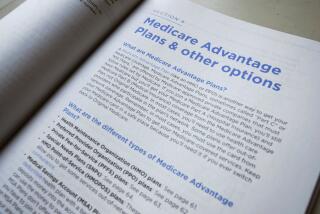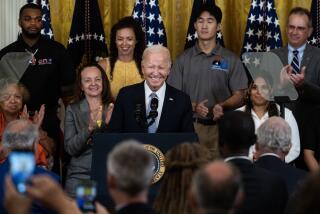Column: Medicare’s stealth price hike: Seniors are paying more for generics even though the drug prices haven’t increased
Here’s a riddle about drug pricing to ask our healthcare administrators, including Health and Human Services Secretary Alex Azar: Since the prices of generic drugs haven’t risen since 2011—in fact, in many cases have fallen—why have out-of-pocket costs for seniors on Medicare nearly doubled?
That’s the finding in a new analysis by the healthcare consulting firm Avalere Health, which studied the trends in co-pay charges for enrollees in Medicare Part D, the prescription drug benefit. The benefit is administered by private insurance companies. The insurers have great latitude to establish out-of-pocket co-pays and structure their formularies—the roster of drugs they cover—as long as they meet broad rules set down by the Centers for Medicare and Medicaid Services, an agency under HHS.
What the insurers have been up to, according to Avalere, is moving many generic drugs into co-pay tiers that require patients to pay larger portions of the drugs’ cost. By shifting more costs onto patients this way, the insurers can keep Part D premiums stable. That’s important to them, since they know that patients generally choose their Part D plans based on premiums. It’s a classic bait-and-switch, because only once they start filling prescriptions do the patients realize what their real costs are.
If CMS decided they didn’t like this practice, they could prevent it. It’s entirely within CMS’ control.
— Dan Mendelson, Avalere Health
The trend can deliver a real jolt to patients. Avalere says that total out-of-pocket costs for the same basket of generic drugs increased by $6.2 billion, or 93%, from 2011 through 2015. In that period, average generics prices increased only 1%, and the volume of generics purchased rose by only 22%. The difference was almost entirely the result of higher co-pays charged per prescription by the insurers.
If left unchecked, this practice will thwart any government initiative to hold drug prices down. One would hope regulators would be on top of this situation, because limiting the growth of generics prices is a linchpin of the Trump administration’s initiative on drug prices. The administration also says it’s determined to hold down prices for Medicare beneficiaries. Yet in announcing the White House’s drug pricing blueprint last week, HHS Secretary Azar soft-pedaled proposals for Medicare to take a firmer stand in negotiating with drug companies, and made no mention of co-pay policies in Part D.
“If CMS decided they didn’t like this practice, they could prevent it,” Dan Mendelson, Avalere’s president and a co-author of the study, told me. “This is entirely within CMS’ control.”
What’s especially worrisome is that among the drugs subject to the up-charges are some of the most widely prescribed and cheapest for seniors, including medications for such chronic conditions as cholesterol, hypertension, and diabetes.
“These are the drugs you want consumers to take,” Mendelson says, because they’re effective in forestalling more serious medical conditions down the road. “You don’t want to set up barriers for patients taking these drugs.” Some are so cost-effective, he adds, that insurers have given them away for free.
Avalere’s analysis was funded by the Assn. for Accessible Medicines, a generics manufacturers trade group. The consultancy says it retained “full editorial control” of the study.
Avalere says that insurers have been gradually increasing the number of tiers into which they slot drugs. When Part D was launched in 2006, most offered four tiers—a single generic tier with the lowest co-pays, two tiers for brand name drugs, “preferred” and “non-preferred,” and a top tier for specialty drugs such as high-priced biologics. Non-preferred drugs are those that aren’t part of the insurers’ standard formularies and therefore are available to patients only for higher out-of-pocket fees.
Drugs in higher tiers also tend to be subject to tighter restrictions on prescriptions—an insurer may disapprove them for any but a limited segment of the patient population, such as those with the most severe conditions.
Since 2006, some 95% of Part D insurers have moved to a five-tier structure by adding a second tier for “non-preferred” generics. Some have established a hybrid tier with some generics and some brand name drugs.
In 2011, the study found, 71% of covered generic drugs were placed in tier 1, the lowest, carrying the smallest co-pays. By 2015, only 19% of covered generics were still in tier 1; about 46% were in tier 2 and 35% in tier 3 or higher. Avalere detected the shift into higher-priced tiers across the entire generics spectrum, even among the cheapest drugs.
Insurers have been looking for new ways to hold down prescription plan premiums in the face of “innovative, expensive new drugs coming down the pike,” Mendelson says. “If you shift costs to the patient who has a chronic illness, you can keep costs lower for everyone else.”
Keep up to date with Michael Hiltzik. Follow @hiltzikm on Twitter, see his Facebook page, or email michael.hiltzik@latimes.com.
Return to Michael Hiltzik’s blog.







